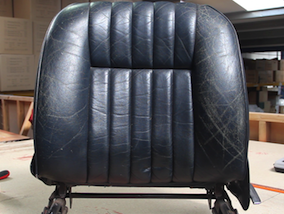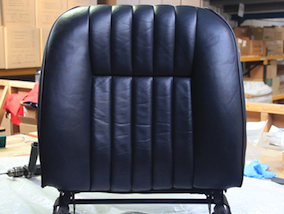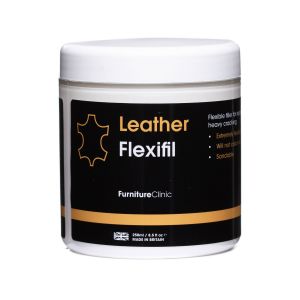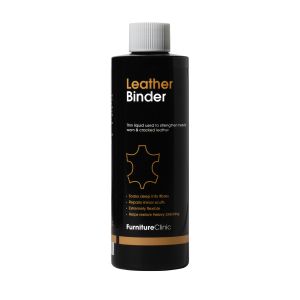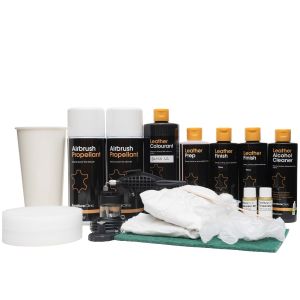This guide will show you how to restore the colour of a leather car seat, using our leather car seat restoration products. Because we can match the colour of leather exactly, you can use our Leather Colourant Kit to restore the full interior, or one car seat, or even just a worn panel.
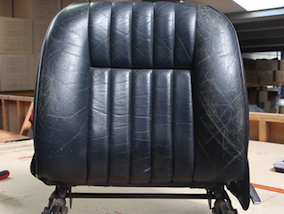
This photo shows a worn leather car seat. In this article we will restore the colour to the two front seats of this car interior.
Products for leather car seat restoration
- Leather Colourant Kit - Used to restore the leather car seat
- Flexifil- To fill cracks (where needed)
- Leather Binder - To strengthen the leather
Restoring leather car seats - step by step
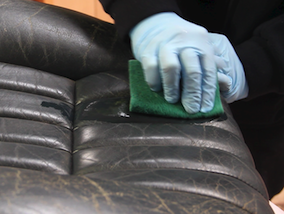
Step: Leather preparation
Apply some of the Leather Prep (included in the Colourant Kit) onto the leather by lining the cotton balls included in the kit, along the centre of the abrasive pad and pouring on some Leather Prep. Fold the abrasive pad over to cover the wet balls and use this to apply to the leather. This allows a controlled release of prep and helps to make the product last longer.
This process will remove the manufactured finish and also some of the colour, which you can see in the photo. After rubbing a small area, wipe it down with a cotton cloth to remove any excess colour from the leather. The leather is correctly prepped when you start to see colour transfer from the leather onto the abrasive pad or cloth.
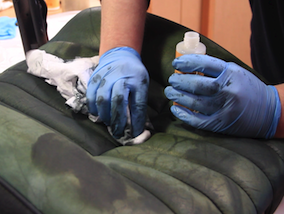
Step 2: Clean the seat with Alcohol Cleaner
The above process will have removed the manufacturers finish and any silicones that are soluble in solvents. There are however some silicones like spray on polish and waxes that aren't soluble in solvents, and so to remove these we need to use the Alcohol Cleaner (included in the Leather Colourant Kit).
Simply wipe the leather down with a cloth dampened in the Alcohol Cleaner, taking care to treat the entire surface. Now wait approximately 30 minutes for the cleaners to evaporate.
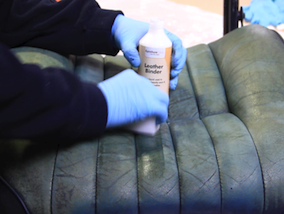
Step: Repairing the leather
Once the leather is dry, it is important, particularly for old or worn leather, to strengthen it with Leather Binder. To do this, simply take a sponge and pour on a small amount of Leather Binder, then use this to work it into the surface of the leather. After applying a full coat, leave to dry. Any build up of binder in crevices or stitching areas should be wiped away before it can dry. Once dry, apply another coat of Binder in the same manner and repeat this process for approximately 8-10 coats.
To smooth over any areas of cracking, the Flexifil is applied using a palette knife and wiped on in a thin layer so that it only goes into the cracks. The filler is then left to dry for about 5-10 minutes, The filler can then be sanded down with very fine sandpaper (1200) to make it smooth. This process can be repeated until all cracking is level with the surface of the leather.
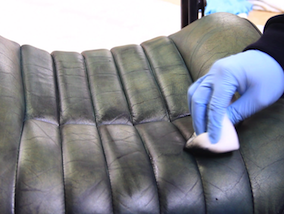
Step 4: Restoring colour to the car seat
When you are satisfied all cracking is filled and the Flexifill has had ample time to completely dry, shake the bottle of Leather Colourant for about three minutes to make sure it is well mixed. Pour a small amount onto a sponge and rub into the leather. The idea is to sponge on a thin coat of colour working it into any gaps, creases and hard to reach areas.
Also notice the on the photo above, after applying the colourant by sponge, we have applied another coat of filler. Sometimes your repair looks perfect until you put the colour on, and then it shows the cracks very lightly. So, if this happens, just re-fill and apply the colour again. There is no need to take the colour off; both products work perfectly with each other.

Step 6: Spray the leather with Colourant and Finish
Once one full coat of colour has been sponged onto the car seat, set up the airbrush and spray a fine coat of colour onto the leather and leave to dry. When dry apply another coat, then repeat this process, building up the colourant in a series of thin coats. There are no hard and fast rules for how many coats should be used, simply apply as many as it takes to sufficiently cover any base colour or repairs made.
When you are satisfied that you have applied sufficient colourant, the Leather Finish should be applied.
The Leather Finish is the same finish that we removed at the start of the process. It’s applied by airbrush so it’s important to ensure your airbrush is cleaned thoroughly after spraying the Leather Colourant.
The kit contains both Gloss and Matt versions of the Leather Finish, which can be mixed together at different ratios to achieve the right level of sheen for your leather. Here is a quick guide to achieving different sheens:
Gloss: 100% Gloss
Semi-Gloss: 75% Gloss and 25% Matt
Satin: 50% Gloss and 50% Matt (this is often used on leather furniture)
Semi-matt: 25% Gloss and 75% Matt (this is what you’d normally find on a car interior)
Matt: 100% Matt
It’s important to thoroughly shake each bottle before opening.
Mix the finishes together to create the version that you’re after, using the guide above as a reference. Once mixed, test the finish on an inconspicuous are to make sure you’re happy with it. You can adjust it by adding more matt or gloss, as needed. If you’re unsure what finish you want, start with Satin and adjust as required from there
Once you’ve found a mixture you’re happy with, it’s time to add the Crosslinker Eco. This should be added at a ratio of roughly 1:8. For reference, add 15ml of Crosslinker to 125ml of Finish.
The finish is applied exactly the same way as the colourant. When you spray the Leather Finish onto the leather, make sure it is dry before spraying on a second coat. Like the Leather Colourant, you can use a hairdryer to speed up this process.
Once the job is complete, wait one day before using the leather.
